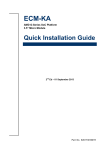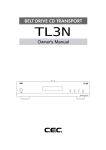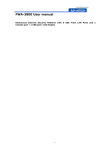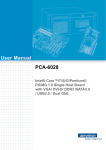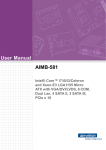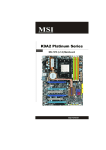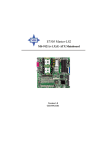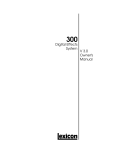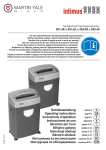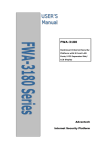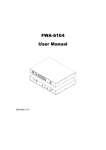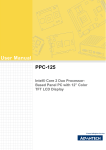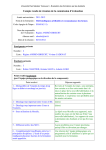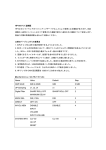Download FWA-3210A/B 1RU Network Application Platform x86
Transcript
FWA-3210A/B 1RU Network Application Platform x86-based Intel® XeonTM E3 series and 2nd generation Core™ i7/i5/i3 processors Startup Manual Specifications Packing List Before installation, ensure that the following materials have been received: • One FWA-3210 Internet Security Platform • One box of accessories • One warranty certificate If any of these items are missing or damaged, please contact your distributor or sales representative immediately. Note: Acrobat Reader is required to view any PDF file. Acrobat Reader can be downloaded at: www. adobe.com/Products/acrobat/readstep2. html (Acrobat is a trademark of Adobe) Main Board Functions • CPU: Intel® Xeon E3-1225/ E3-1275 (FWA-3210A only), and 2nd gen. Core™ i7-2600/i5-2400(FWA-3210B only), i3-2120, Pentium®-G850, Celeron®-G540 Processors • Chipset: Intel® C206 PCH/ H61 PCH • BIOS: AMI™ • Memory: Dual channel DDR3 1333/1066 MHz ECC (Xeon® processors only) Un-buffered memory, up to 32GB (FWA-3210A) /16GB(FWA-3210B) • Ethernet: 6 x Intel® 82574L 10/100/1000 Mbps Ethernet with optional 3 segment bypass • PCIe Bus: -1xGen2, PCI-E x8 gold finger support NMC module -1xGen2, PCI-E x8 or 2 x4 Add-on Card slot (C206 only) • C-Fast Interface: 1 x C-Fast Socket • Storage: 1 x 3.5”or 1 x 2.5” internal HDD / SSD • Peripherals: -USB 2 x USB2.0 ports on front panel -Serial 1 x front console port RJ45 -LCD Module 1 x2 character display • Dimensions(W x L x H): 430mmx500mmx44mm • Weight: 10Kg • Environment: Operating Non-operating • Temperature: 0°C~ 40°C -20°C ~ 75°C (32°F~104°F) (-4°F~167°F) • Humidity: 5% ~ 85% @40°C(104°F) 5% ~ 95% For more information on this and other Advantech products, please visit our website at: http://www.advantech.com.tw/support http://www.advantech.com. For technical support and service, please visit our support website at: http://www.advantech.com/support This manual is for the FWA-3210 series Rev. A Part No. 2002321000 Printed in China 1st Edition, Jan. 2012 FWA-3210 Startup Manual 1 Specifications Express Modules FWA-3210A Redundant • Interface: - GbE Express Module: Supports 4 ports 10/100/1000 Base-T copper module Supports 4 ports 10/100/1000 Base-X SFP module - 10GE Express Module: Supports 2 ports 10 GbE Base-F SFP+ module • Controller: - GbE Express Module 2 x Intel® 82576 Dual Port GbE controllers - 10GbE Express Module: 1x Intel® 82599 2-port 10 GbE controller • Dimensions (W x D): 72 x 172 mm Front view Figure 1: NMC-0103 4-port RJ45 GE Module Back View FWA-3210B Single PSU Front view Figure 2: NMC-0102 4-port SFP GE Module Figure 3: NMC-1001 2 ports SFP+ 10GE Module 2 FWA-3210 Startup Manual Back View Installation Installing the CPUs Installing the heatsink and air scoop 1. Locate the CPU sockets on the board. 1. Unwrap heatsink and black Mylar air scoop. There are two threaded holes on each side of the heatsink that accommodate the air scoop screws. 2. Put heat sink and air scoop in place as shown. 2. Taking one CPU at a time, remove the protective shield, if present, and press the load lever and move it out till it is clear of the retention tab, and raise it. 3. Use the four black screws to attach the air scoop to the heatsink. 3. Make sure that alignment triangle on the CPU lines up with the correct corner on the socket, and ease the CPU into place. 4. Align and carefully lower the heatsink into place. 4.Close the load plate and push the load lever back down until it engages the retention tab. 5. Insert and loosely engage each heat sink screw. Then tighten carefully to secure the heat sink. FWA-3210 Startup Manual 3 Installation 4. Release the screws and remove the riser card bracket. 5. Install the add-on card to riser card. Installing the Riser Cards 1. Release four screws from chassis base and take out the bracket. 2. Release the first IO bracket screw and remove the first IO bracket. 3. Install the add-on card and secure with screw. 4 FWA-3210 Startup Manual 6. Replace brackets and secure firmly with screws. Installation Installing Express Modules Installing 3.5” HDD Modules 1. Release two screws on the base chassis and remove the bracket. 1. Release the four screws and remove 3.5” HDD bracket. 2. Carefully install the NMC-10xx module. 2. Install one 3.5” HDD on the bracket with four screws. 3. Install 3.5” HDD module on the base chassis with four screws. 3. Secure with two screws. FWA-3210 Startup Manual 5 Installation Installing 2.5” HDD Modules 1. Please release four screws and remove 2.5” HDD bracket. Jumpers and Connectors The board has a number of jumpers that allow you to configure your system to suit your application. The table below lists the function of each of the jumpers and connectors. Jumper/Connector list 2. Install the first 2.5” HDD in the bracket with four screws. 3. Install the second 2.5” HDD in the bracket with four screws. 4. Install 2.5” HDD module on the base chassis with four screws. Label Function CMOS1 Clear CMOS JWDT1~4 Short watchdog JVGPIO1 Short GPIO power JUART1 Short selection BMC PSON1 Short ATX LPT1 Parallel port USB34 Internal USB VGA1 VGA connector COM2 Serial port LPC1 Debug port KBMS1 PS2 Keyboard/Mouse SYSFAN1~4 FAN connector SATA_PWR1 5V SATA power connector SYS_RST1 Reset system button PWR_BTN1 System power on/off button HDD_LED1 HDD LED pin header PWR_LED1 5V power led pin header JCASE1 Case open connector Status_LED1~3 LAN1-2~LAN5-6 Bypass status LED BP_Force1~3 LAN1-2~LAN5-6 Bypass force button JTAG1 Burn in data JTAG2 Burn in CPLD data FP1 Front panel GPIO1 GPIO function CMOS1 Pins Result 1-2 Normal* 2-3 Clear CMOS *: Default 1 2 3 Keep CMOS data* 6 FWA-3210 Startup Manual 1 2 3 Clear CMOS data Jumpers and Connectors JWDT1~4 LPT1: Parallel port (for LCM module usage) Pins Result Pins Result 1-2 Short watchdog is WDT_OUT1~4_N* 1 PIO_STB 2-3 Short watchdog is WDT_OUT0_N 2 #AFD 3 PIO_PD0 4 #ERR 5 PIO_PD1 6 #INIT 7 PIO_PD2 *: Default 1 2 3 1 2 3 JVGPIO1 Pins Result 8 #SLIN 1-2 Short GPIO power +V5_SB* 9 PIO_PD3 2-3 Short GPIO power +V3.3_SB 10 GND 11 PIO_PD4 12 GND 13 PIO_PD5 14 GND 15 PIO_PD6 Result 16 GND 1-2 Short selection BMC_UART_ SWTCH# signal* 17 PIO_PD7 18 GND 2-3 Short selection BMC_DETECT# signal 19 #ACK 20 GND 21 BUSY 22 GND 23 PE 24 GND 25 SLCT 26 GND *: Default 1 2 3 1 2 3 JUART1 Pins *: Default 1 2 3 1 2 3 PSON1 Pins Result 2-3 Short ATX* 1-2 Short AT LPT1 *: Default 1 2 3 1 2 3 1 3 5 7 9 11 13 15 17 19 21 23 25 2 4 6 8 10 12 14 16 18 20 22 24 26 FWA-3210 Startup Manual 7 Pins Result 1 USBV1 1 GND_F 2 USBV1 2 NC 3 USB9_z_P- 3 SERIAL2_DTR 4 USB9_z_P- 4 SERIAL2_RI 5 USB9_z_P+ 5 SERIAL2_TXD 6 USB9_z_P+ 6 SERIAL2_CTS 7 GND 7 SERIAL2_RXD 8 GND 8 SERIAL2_RTS 9 GND 9 SERIAL2_DCD 10 SERIAL2_DSR 8 Result 6 COM2: Serial port Pins 4 Internal USB port3,4 2 Jumpers and Connectors USB34 9 7 5 3 1 COM2 VGA1: VGA connector 9 10 7 8 5 6 3 4 1 2 Pins Result 1 VGA_R 2 CRT_VCC LPC1: Debug port 3 VGA_G Pins Result 4 GND 1 LPC_FRAME# 5 VGA_B 2 GND 6 N/C 3 LPC_AD0 7 N/C 4 CLK33M_LPC0 8 V_SDAT 5 LPC_AD1 9 GND_V 6 PCI_SERIRQ 10 HSYNC 7 LPC_AD2 11 GND_V 8 PLTRST_SIO# 12 VSYNC 9 LPC_AD3 13 GND_V 10 +V3.3 14 V_SCLK 15 GND_V WB_5x2V_2.00mm LPC1 8 FWA-3210 Startup Manual BH_8x2V_2.00mm 1 3 5 7 9 11 13 15 2 4 6 8 10 12 14 16 VGA1 9 10 7 8 5 6 3 4 1 2 Jumpers and Connectors KBMS1: PS2 Keyboard/Mouse PWR_BTN1: System power on/off button Pins Result Pins Result 1 MSCK 1 FP_PANSWIN# 2 KBMS_VCC 2 GND 3 GND 4 MSDT 5 KBDT 6 KBCK 1 2 HDD_LED1: HDD LED pin header 6 5 4 3 2 1 KBMS1 Pins Result 1 VCC 2 SATA_LED 1 2 SYSFAN1~4: FAN connector Pins Result 1 GND 2 +12V 3 FAN_SPEED0 4 FAN_PWM PWR_LED1: 5V power led pin header Pins Result 1 +V5 2 GND 1 2 4 3 2 1 SYSFAN1 W_4V_2.54mm SATA_PWR1: 5V SATA power connector JCASE1: Case open connector Pins Result 1 CASEOP# 2 GND Pins Result 1 +V5 2 GND 3 GND LED1~3: LAN1-2~LAN5-6 Bypass status display 4 +V12 Pins Result 1 RELA_ON_0# /1# /2# 2 RELA_ON_0/1/1 1 2 4 3 2 1 SATA_PWR1 1 2 SYS_RST1: Reset system button Pins Result 1 SRST_IN# 2 GND 1 2 BP_FORCE1~3: LAN1-2~LAN5-6 Bypass force button Pins Result 1 BTN_SW1/SW2/SW3 2 +V3.3A 1 2 FWA-3210 Startup Manual 9 Jumpers and Connectors JTAG1: Burn in data FP1 front panel Pins Result Pins Result 1 JTAG_TCK 1 +V5 2 +V3.3 2 GND 3 JTAG_TMS 3 Power button 4 GND 4 SYSTEM RESET 5 JTAG_TDI 5 SMBUS CLK 6 GND 6 SMBUS DATA 7 JTAG_TDO 7 +V3.3 8 GND 8 SATA_LED# 9 JTAG_RST# 10 +V3.3 JTAG1 1 3 5 7 9 2 4 6 8 10 JTAG2: Burn in CPLD data Pins Result 1 +V3_SB 2 TDO 3 TDI 4 NC 5 TMS 6 GND 7 TCK 1 2 3 4 5 6 7 JTAG2 GPIO1: GPIO function Pins Result 1 PCA_GPIO0 2 PCA_GPIO4 3 PCA_GPIO1 4 PCA_GPIO5 5 PCA_GPIO2 6 PCA_GPIO6 7 PCA_GPIO3 8 PCA_GPIO7 9 VCC_GPIO 10 GND 1 3 5 7 9 Software Installation Software tested list: • Windows Server2008 • Windows Server2003 • Windows 7 Ultimate • Windows Vista Enterprise SP1 10 FWA-3210 Startup Manual • Red Hat Enterprise 5.4 • RHEL 6.1 • SUSE 11.1 • Fedora core 15 • Red Hat Enterprise 5.4 GPIO1 2 4 6 8 10 Board Placement SYSFAN2 SYSFAN1 SYSFAN3 ATX12v1 GF1 DIMMB2 DIMMB1 DIMMA2 DIMMA1 GF2 USB34 SATA2 SATA3 SATA_PWR1 KBMS1 SYSFAN4 CF1 JCMOS1 JTAG2 VGA1 ATXPWR1 JTAG1 PSON1 LOM1 PWR_LED1 HDD_LED1 GPIO1 FP1 LPT1 LPC1 SATA1 SYS_RST1 PWR_BTN1 SATA0 COM2 COM1_USB12 BK JUART1 JWDT1 JCASE1 JWDT3 JWDT4 A 57 1 JWDT2 JVGAPIO1 EXPCIE1 0 STATUS_LED1 STATUS_LED2 STATUS_LED3 LAN1 LAN2 LAN3 LAN4 LAN5 LAN6 FWA-3210 Startup Manual 11 Safety Instructions 1. Read these safety instructions carefully. 2. Keep this user manual for later reference. 3. Disconnect this equipment from AC outlet before cleaning. Do not use liquid or spray detergents for cleaning. 4. For pluggable equipment, the power outlet shall be installed near the equipment and shall be easily accessible. 5. Keep this equipment away from humidity. 6. Put this equipment on a reliable surface during installation. Dropping it or letting it fall could cause damage. 7. Do not leave this equipment in an environment unconditioned where the storage temperature under 0°C (32°F) or above 40°C (104°F), it may damage the equipment. 8. The openings on the enclosure are for air convection hence protects the equipment from overheating. DO NOT COVER THE OPENINGS. 9. Make sure the voltage of the power source is correct before connecting the equipment to the power outlet. 10. Place the power cord such a way that people can not step on it. Do not place anything over the power cord. The voltage and current rating of the cord should be greater than the voltage and current rating marked on the product. 11. All cautions and warnings on the equipment should be noted. 12. If the equipment is not used for long time, disconnect it from the power source to avoid being damaged by transient overvoltage. 13. Never pour any liquid into ventilation openings. This could cause fire or electrical shock. 14. Never open the equipment. For safety reasons, the equipment should be opened only by qualified service personnel. 15. If any of the following situations arises, get the equipment checked by service personnel: a. The power cord or plug is damaged. b. Liquid has penetrated into the equipment. c. The equipment has been exposed to moisture. d. The equipment does not work well or you cannot get it to work according to user manual. e. The equipment has been dropped and damaged. f. The equipment has obvious signs of breakage. 16. CAUTION: The computer is provided with a battery-powered real-time clock circuit. There is a danger of explosion if bat¬tery is incorrectly replaced. Replace only with same or equivalent type recommended by the manufacture. Discard used batteries according to the manufacturer’s instructions. 17. THE COMPUTER IS PROVIDED WITH CD DRIVES THAT COMPLY WITH APPROPRIATE SAFETY STANDARDS, INCLUDING IEC 60825. 18. This device complies with Part 15 of the FCC rules. Operation is subject to the following two conditions: (1) this device may not cause harmful interference, and (2) this device must accept any interference received, including interference that may cause undesired operation. 19. CAUTION: Always completely disconnect the power cord from your chassis whenever you work with the hardware. Do not make connections while the power is on. Sensitive electronic components can be damaged by sudden power surges. 20. CAUTION: Always ground yourself to remove any static charge before touching the motherboard, backplane, or add-on cards. Modern electronic devices are very sensitive to static electric charges. As a safety precaution, use a grounding wrist strap at all times. Place all electronic components on a static-dissipative surface or in a static-shielded bag when they are not in the chassis. 21. CAUTION: Any unverified component could cause unexpected damage. To ensure the correct installation, please always use the components (ex. screws) provided with the accessory box. 12 FWA-3210 Startup Manual Safety Instructions 22. Caution text concerning lithium batteries: ADVARSEL! Lithiumbatteri - Eksplosionsfare ved fejlagtig håndtering. Udskiftning må kun ske med batteri af samme fabrikat og type. Levér det brugte batteri tilbage tilleverandøren. 23. “Rack Mount Instructions - The following or similar rack-mount instructions are included with the installation instructions: A) Elevated Operating Ambient - If installed in a closed or multi-unit rack assembly, the operating ambient temperature of the rack environment may be greater than room ambient. Therefore, consideration should be given to installing the equipment in an environment compatible with the maximum ambient temperature (Tma) specified by the manufacturer. B) Reduced Air Flow - Installation of the equipment in a rack should be such that the amount of air flow required for safe operation of the equipment is not compromised. C) Mechanical Loading - Mounting of the equipment in the rack should be such that a hazardous condition is not achieved due to uneven mechanical loading. D) Circuit Overloading - Consideration should be given to the connection of the equipment to the supply circuit and the effect that overloading of the circuits might have on overcurrent protection and supply wiring. Appropriate consideration of equipment nameplate ratings should be used when addressing this concern. E) Reliable Earthing - Reliable earthing of rack-mounted equipment should be maintained. Particular attention should be given to supply connections other than direct connections to the branch circuit (e.g. use of power strips).” FWA-3210 Startup Manual 13















